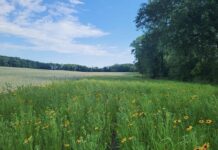I love those moments when I am talking with someone about a natural resources issue and I actually see the light bulb turn on. I had one of those moments several summers ago on a camping trip with one of my close friends, and recollect it proudly on rainy days like these.
We were about to pitch a tent on a camping trip. The sun was fading on the horizon, and there was rain in the forecast. I surveyed the situation critically for several moments. In haste to get our tiny shelter constructed, my friend started to drag the tent poles towards her chosen location, and I told her absolutely not.
She protested as I pulled the tent poles several feet in the other direction, and she began arguing her point that it was a perfect, level spot for the tent, a rarity in southeastern Ohio. I simply asked her to trust me on this one.
Result
Three rainy days later, our little tent sat on the only slip of dry ground in sight, surrounded by a moat of muddy water. The ‘level’ location that she had chosen, on other hand, was six inches deep in standing water.
The light bulb went on. For weeks, my friend told everyone who would listen that she finally understood what I did at my job. Well, I wouldn’t say she understood exactly, but at least she recognized that she had faced a real- life, albeit simple, natural resources challenge and her Soil and Water District friend helped her through it.
And for anyone reading this column, sometimes it is just that easy. Those of us working with land uses can often see the problems that might come later, long before a decision is made.
We catch the almost imperceptible slope change that makes the difference between dry or miserably wet, whether we are looking at a tent site or a heavy use pad location.
We can tell a landowner with relative certainty that it is no use throwing hard-earned money at re-seeding a pasture if he has no intention of changing his management style, because we can already see the cattle destroying it during next year’s rainy season.
We can see the house foundation shifting on reclaimed soils, years before the house is ever built.
Purpose
The Soil and Water District is both expert and jack of all trades. Land uses vary vastly across the state and it is our business to know our local concerns and be armed with the knowledge and partnerships to address them accordingly.
The Districts are powerfully connected to one another and their partners, and seamlessly draw one another’s expertise when needed. If you are drowning in muddy water this spring, think back. Could you have called on a Soil and Water Conservation District for ideas to help you address the hillside runoff behind your barn?
Could you have asked them to design a rain garden to address a storm water issue? Could you have called and asked them how large the watershed above the dam was before a few thousand dollars washed away?
We are land use planners by nature, conscious of the hows and whys and what-ifs of land use. We chose these careers so that we could help others make sustainable, economical and smart choices with the land.
We serve you locally with a smile and work as your liaison and your advocate. We feel your frustration and celebrate your successes as if they were our own.
Call us
So in a way, I guess my friend was right. Siting the tent on higher ground is what we do. Land use is our job and our passion. So call your Soil and Water Conservation District today. We are waiting to hear from you.













Thank you for explaining what you do and listing some of the questions I can ask my SWCD about my property. I found your Farm and Dairy article from a May 12 tweet by soilandwater OFSWCD on twitter. I just learned how to use Twitter this past semester in one of my KSU courses.